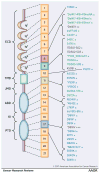Advances in the Classification and Treatment of Mastocytosis: Current Status and Outlook toward the Future
- PMID: 28254862
- PMCID: PMC5354959
- DOI: 10.1158/0008-5472.CAN-16-2234
Advances in the Classification and Treatment of Mastocytosis: Current Status and Outlook toward the Future
Abstract
Mastocytosis is a term used to denote a heterogeneous group of conditions defined by the expansion and accumulation of clonal (neoplastic) tissue mast cells in various organs. The classification of the World Health Organization (WHO) divides the disease into cutaneous mastocytosis, systemic mastocytosis, and localized mast cell tumors. On the basis of histomorphologic criteria, clinical parameters, and organ involvement, systemic mastocytosis is further divided into indolent systemic mastocytosis and advanced systemic mastocytosis variants, including aggressive systemic mastocytosis and mast cell leukemia. The clinical impact and prognostic value of this classification has been confirmed in numerous studies, and its basic concept remains valid. However, refinements have recently been proposed by the consensus group, the WHO, and the European Competence Network on Mastocytosis. In addition, new treatment options are available for patients with advanced systemic mastocytosis, including allogeneic hematopoietic stem cell transplantation and multikinase inhibitors directed against KIT D816V and other key signaling molecules. Our current article provides an overview of recent advances in the field of mastocytosis, with emphasis on classification, prognostication, and emerging new treatment options in advanced systemic mastocytosis. Cancer Res; 77(6); 1261-70. ©2017 AACR.
©2017 American Association for Cancer Research.
Conflict of interest statement
Figures

References
-
- Valent P, Akin C, Sperr WR, Horny HP, Arock M, Lechner K, et al. Diagnosis and treatment of systemic mastocytosis: state of the art. Br J Haematol. 2003;122:695–717. - PubMed
-
- Horny HP, Sotlar K, Valent P. Mastocytosis: state of the art. Pathobiology. 2007;74:121–32. - PubMed
-
- Arock M, Valent P. Pathogenesis, classification and treatment of mastocytosis: state of the art in 2010 and future perspectives. Expert Rev Hematol. 2010;3:497–516. - PubMed
-
- Caplan RM. The natural course of urticaria pigmentosa: analysis and follow-up of 112 cases. Arch Dermatol. 1963;87:146–57. - PubMed

